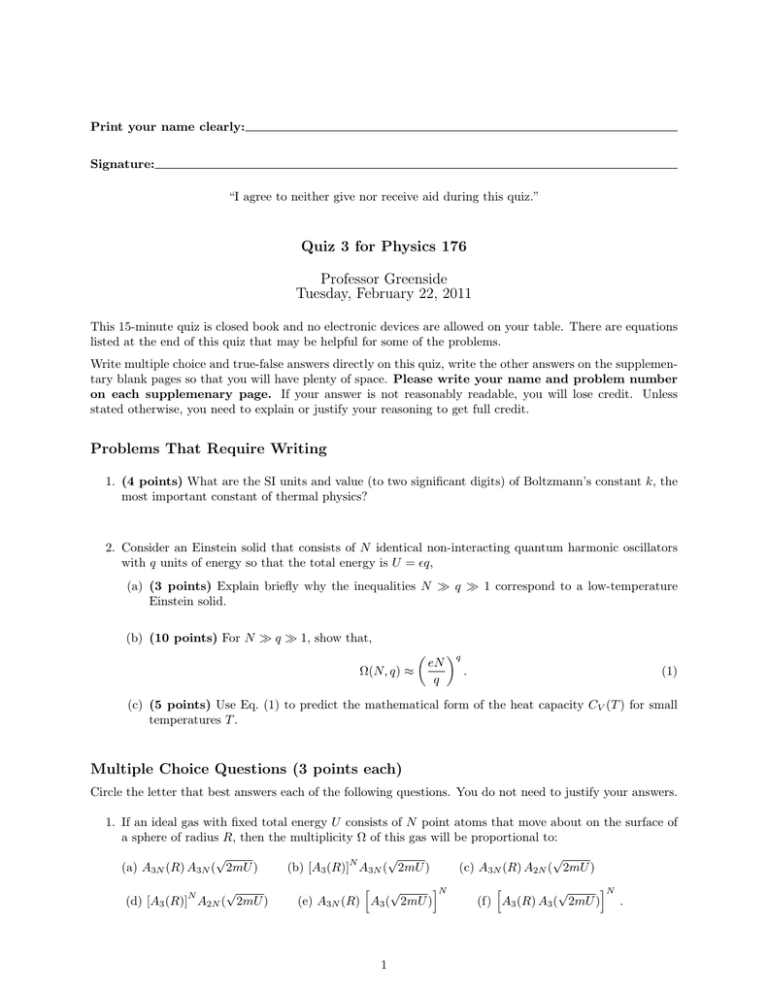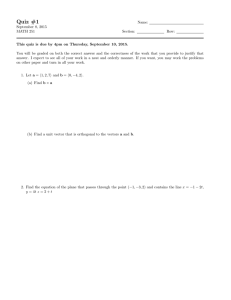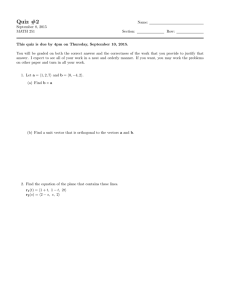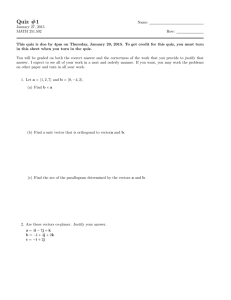Quiz 3 for Physics 176 Professor Greenside Tuesday, February 22, 2011
advertisement

Print your name clearly: Signature: “I agree to neither give nor receive aid during this quiz.” Quiz 3 for Physics 176 Professor Greenside Tuesday, February 22, 2011 This 15-minute quiz is closed book and no electronic devices are allowed on your table. There are equations listed at the end of this quiz that may be helpful for some of the problems. Write multiple choice and true-false answers directly on this quiz, write the other answers on the supplementary blank pages so that you will have plenty of space. Please write your name and problem number on each supplemenary page. If your answer is not reasonably readable, you will lose credit. Unless stated otherwise, you need to explain or justify your reasoning to get full credit. Problems That Require Writing 1. (4 points) What are the SI units and value (to two significant digits) of Boltzmann’s constant k, the most important constant of thermal physics? 2. Consider an Einstein solid that consists of N identical non-interacting quantum harmonic oscillators with q units of energy so that the total energy is U = ²q, (a) (3 points) Explain briefly why the inequalities N À q À 1 correspond to a low-temperature Einstein solid. (b) (10 points) For N À q À 1, show that, µ Ω(N, q) ≈ eN q ¶q . (1) (c) (5 points) Use Eq. (1) to predict the mathematical form of the heat capacity CV (T ) for small temperatures T . Multiple Choice Questions (3 points each) Circle the letter that best answers each of the following questions. You do not need to justify your answers. 1. If an ideal gas with fixed total energy U consists of N point atoms that move about on the surface of a sphere of radius R, then the multiplicity Ω of this gas will be proportional to: √ (a) A3N (R) A3N ( 2mU ) √ N (d) [A3 (R)] A2N ( 2mU ) √ N (b) [A3 (R)] A3N ( 2mU ) h iN √ (e) A3N (R) A3 ( 2mU ) 1 √ (c) A3N (R) A2N ( 2mU ) h iN √ (f) A3 (R) A3 ( 2mU ) . True or False Questions (2 points each) For each of the following statements, please circle T or F to indicate respectively whether a given statement is true or false. You do not have to justify your answers. 1. T / F The fundamental assumption of statistical physics is that, for an isolated system, the macrostate with the most microstates is the one that is observed experimentally. 2. T / F For an isolated system with constant total energy U , the total number of accessible microstates is also constant (does not change with time). 3. T/ F At room temperature and atmospheric pressure, the entropy of one mole of argon atoms is the same as the entropy of one mole of helium atoms. 4. T / F The heat capacity CV of gaseous diatomic hydrogen in the temperature range 1000 K < T < 3000 K can be quantitatively understood in terms of Einstein’s theory of a solid. 5. T / F The Sackur-Tetrode equation, which describes the entropy S of a monoatomic gas, is consistent with the requirement that S ≥ 0 for all positive values of U , N , and V . 6. T/ F (−1)! = ∞. The following formulas may be useful: µ ¶ N +q−1 , q µ ¶ m m! Ω(N, q) = = . n n!(m − n)! Ã " µ µ ¶ ¶3/2 #! 1 ∂ln Ω 5 V 4πm U S = k ln Ω, . = , S = Nk + ln kT ∂U V,N 2 N 3h2 N Z ∞ 2 π d/2 d−1 Ad (r) = r , x! = Γ(x + 1) = tx e−t dt, Γ(x + 1) = x Γ(x). Γ(d/2) 0 ² ln(x!) ≈ x ln(x) − x for x À 1, ln(a + ²) ≈ ln(a) + for |²/a| ¿ 1. a 2




